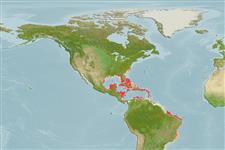Environment: milieu / climate zone / intervalo de profundidade / distribution range
Ecologia
marinhas; estuarina associadas(os) a recifes. Subtropical
Western Atlantic: Bermuda, Florida Keys (USA), and Bahamas to northern South America. Scarce in western Gulf of Mexico (Ref. 26938).
Tamanho / Peso / Idade
Maturidade: Lm ? range ? - ? cm
Max length : 15.0 cm TL macho/indeterminado; (Ref. 7251); 50.0 cm TL (female)
A very, slender, elongate, cylindrical eel with a projecting lower jaw. Lateral line complete ending at base of tail. (Ref. 26938).
Body shape (shape guide): eel-like.
Young and females burrow in sandy tide pools and reef tracts. Males inhabit deeper water, possibly pelagic. Adults emerge at night and sometimes come to lights at the surface (Ref. 26938). Feed on burrowing invertebrates that live in the sand (Ref. 26938).
Life cycle and mating behavior
Maturidade | Reprodução | Desova | Ovos | Fecundidade | Larvas
Robins, C.R. and G.C. Ray, 1986. A field guide to Atlantic coast fishes of North America. Houghton Mifflin Company, Boston, U.S.A. 354 p. (Ref. 7251)
Categoria na Lista Vermelha da IUCN (Ref. 130435: Version 2025-1)
Ameaça para o homem
Harmless
Utilização humana
Ferramentas
Relatórios especiais
Descarregue XML
Fontes da internet
Estimates based on models
Preferred temperature (Ref.
123201): 23.8 - 28.2, mean 27.3 °C (based on 786 cells).
Phylogenetic diversity index (Ref.
82804): PD
50 = 0.5002 [Uniqueness, from 0.5 = low to 2.0 = high].
Bayesian length-weight: a=0.00102 (0.00046 - 0.00225), b=3.06 (2.88 - 3.24), in cm total length, based on all LWR estimates for this body shape (Ref.
93245).
Nível Trófico (Ref.
69278): 3.5 ±0.37 se; based on food items.
Fishing Vulnerability (Ref.
59153): Moderate vulnerability (40 of 100).
🛈
Nutrients (Ref.
124155): Calcium = 50 [20, 135] mg/100g; Iron = 0.584 [0.290, 1.102] mg/100g; Protein = 19.1 [16.8, 21.6] %; Omega3 = 0.203 [0.081, 0.560] g/100g; Selenium = 10.4 [4.1, 25.2] μg/100g; VitaminA = 114 [26, 489] μg/100g; Zinc = 1.4 [0.8, 2.2] mg/100g (wet weight);
